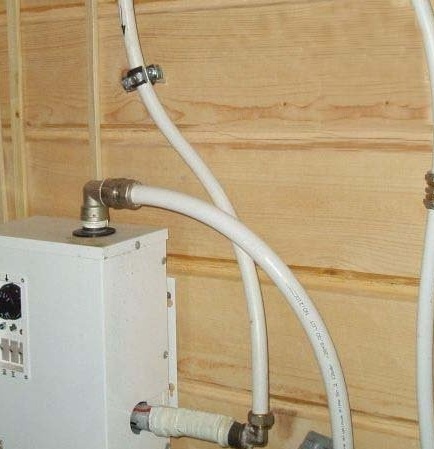
Hello dear readers and friends.
A few years ago I made for my good friends an electric heating system for their house, which stands near the forest, three blocks from my house.
Personally, this was not the first time for me, everything was done leisurely, from ordinary, inexpensive components, according to a scheme tested over the years, with the most convenient and reliable solutions, with all the protection and control systems that I personally invented.
The main criteria in the development and installation of this system were: the possibility of long-term operation without human intervention, maximum reliability of components, maximum possible protection against accidents, low price of equipment, maximum standardization of used components and parts, maximum maintainability, the possibility of quick repairs by unqualified personnel or even the owner himself .
This whole system worked perfectly until my friends got the idea to put gas into their house. This idea did not arise from scratch.
Our village is gasified. At least that's what the administration believes. In fact, only those who can afford it, or those who managed to connect back in Soviet free times, have gas. Now this pleasure is not cheap. I personally do not have gas. But this is not here and not now.
My friends were lucky, their neighbor next to me, from the new Russians, decided to spend a lot of money, spent his gas, and the opportunity appeared to connect to this pipe. Inexpensive, for only 250,000 rubles. Sorry, no comment here.
They carried out the pipe in a month, six months later, all the paperwork was drawn up and gas was supplied.
In the meantime, coordination was underway, I started reworking the existing electric heating system.
I will immediately answer the question of why the alteration. It is much easier to remove all electrical equipment and supply gas. It will be cheaper and easier. Excuse me generously, but ... this is not entirely true. People in this house do not live permanently, but come on weekends, holidays, or on vacation. In winter, it makes no sense to constantly keep a gas boiler in operation, which even at the very minimum value of the thermostat consumes quite a lot of gas. Looking ahead, I’ll say that in our case we used a non-volatile parapet gas boiler with a wick on duty. In gorgaz and in the instructions strictly stated that such a boiler can not be left unattended.Therefore, during a long absence of the owners, electric heating works as before, at a minimum temperature of +5 degrees.
The electric heating system is simple, open type, made according to a single-tube sequential circuit, with forced circulation of antifreeze. There are 9 batteries in the system, the most common ones are of a calorifer type.
The temperature of the electric boiler is controlled by a capillary thermostat mounted on the pipe "return". The electric boiler protection is three-level, it monitors the liquid level sensor in the expansion tank (float with reed switch), the speed of the liquid moving through the system (flow sensor), and the maximum temperature of the heating elements (another thermostat). Now a fourth lock has appeared, which works when the gas boiler is turned on. In the event of an accident, the red lamp lights up and the heating switches off. The circulation pump runs continuously while the heating is on.

Electric heating at work. The lamp "network" and the pump operation indicator are on. On the switches of the heating elements, the load indicators light up. Now included 1500 + 1500 watts.

Before the alteration, it looked like this. Under the electric boiler, a voltage stabilizer, ferroresonant type, from a Soviet color TV is installed. It is needed for reliable and stable operation of the circulation pump, at low voltage, especially at low speeds. Two pipes going up - this is to the expansion tank, in my systems it is always flowing. The colored light bulbs at the bottom left are not related to heating, it is from the water supply.

Here you can see the return pipe, it has a circulation pump, a flow sensor (such a yellow one), a drain (but at the same time a bulk) valve, and two valves on the sides of the pump for quick replacement without draining the fluid from the system. Tubes above and below are water supplies.
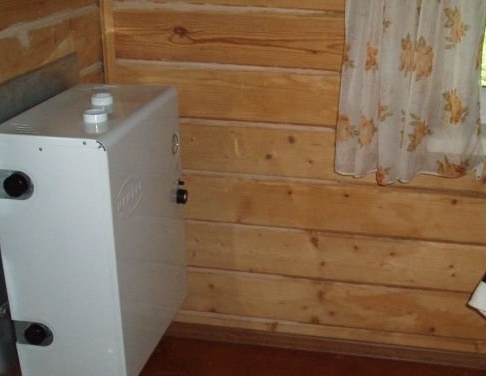
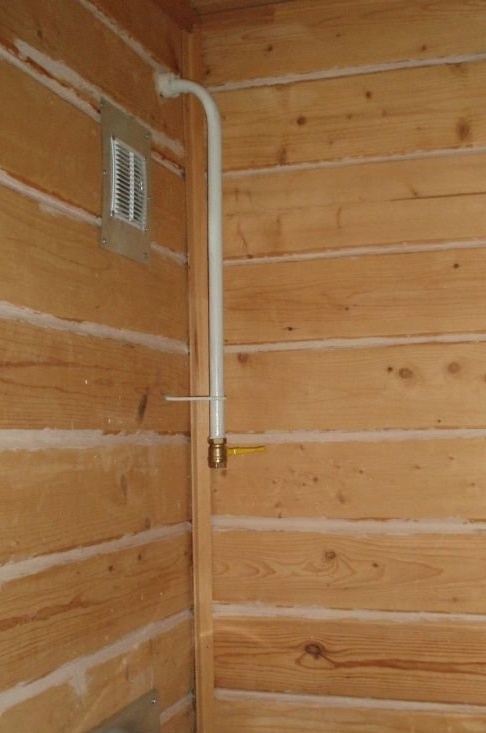
And now about the gas. Here you can clearly see the boiler just installed on the wall and the gas pipe with a tap.
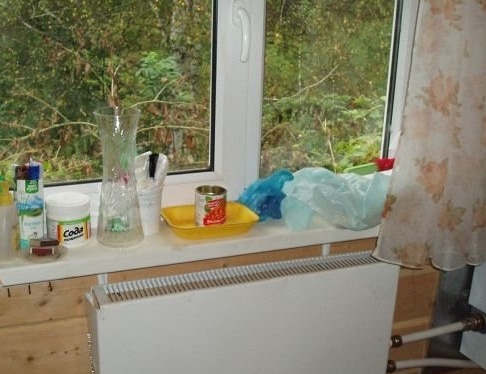

And here in the photo the “tricky” battery and the gas boiler itself are already installed, but not yet connected to the gas main. The trick of this battery is that during the operation of the gas boiler, the coolant circulates through the lower pipe, bypassing the boiler, and when operating from electricity, the coolant circulates through its upper part, passing through the boiler, which in this case is also warm. This is shown in the photo by green and red lines.
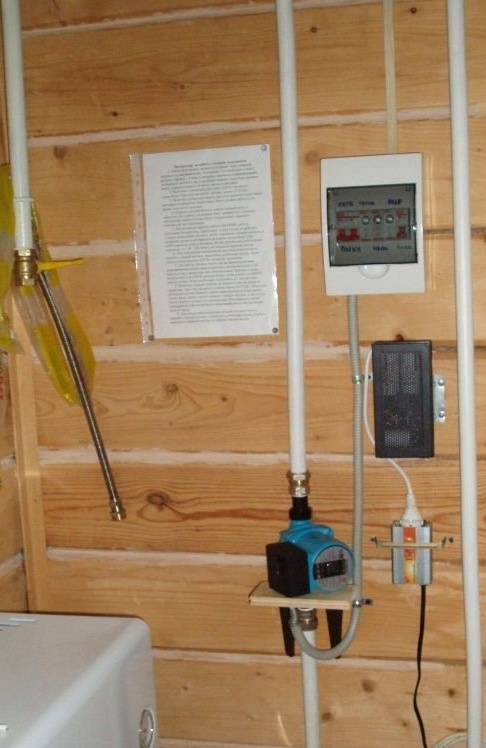
In these photos, in fact, almost the entire gas heating system. The batteries and pipes in the rooms, I think, are of no interest to anyone. A large thick pipe going up is the exit from the boiler, the supply of heated coolant to the system. The two pipes at the top, on the right, above the pump, go to the flow expansion tank, into the attic. The black box near the pump with the wire is a 12 volt 300 watt inverter, for emergency power supply to the circulation pump in the event of a power outage. I note that even without a pump, a gas boiler works fine (it should work like that), just the house warms up for a long time.
When working on gas, the coolant flows through the thick pipe into the house, passes through the bathroom, bedroom, living room, returns to the kitchen, and through the lowest pipe through the extreme battery goes to the expansion tank, from which it goes down to the pump and enters the boiler for heating. The expansion tank is now common to both gas and electric; it was moved closer to the gas boiler.
To switch from electricity to gas, you need to close two taps, one in the bathroom (blue), the other in the kitchen (red). To return to the electric cranes must be opened.
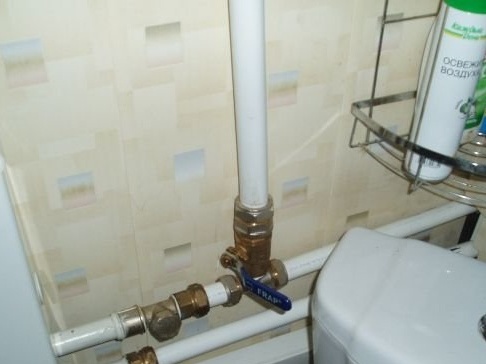
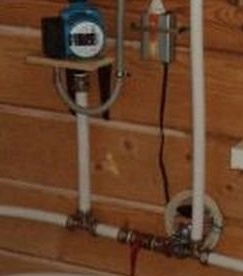
About protection. Temperature control in the heating system is done by the automation of the gas boiler. She also monitors the traction and the shutdown of the gas when the wick fades.
Mine, an additional protection unit for a gas boiler, (seephoto above) is made in a conventional switchboard and monitors the following parameters:
Liquid level in a broad tank.
The maximum temperature at the outlet of the gas boiler.
Fluid flow rate in the system (flow sensor)
Control the opening of taps for switching from electric heating to gas.
I will especially say about this. It is clear that if the taps are not opened, there will be no circulation and the gas boiler may overheat. To do this, small magnets were installed in the handles of two cranes using heat-shrink cambric, and reed switches were installed nearby, directly on the pipe, in the same heat-shrink.
They are not yet in the photographs, these photos were taken during installation.
If at least one tap handle is closed, the protection relay will break the thermocouple power circuit in the gas boiler and it will not start. Other contacts of the same relay control the inclusion of an electric heater.
So that's it. In winter, when there is no one in the house, electric heating is turned on, set to + 5 degrees. When the owner arrives, he turns off the electric heater, opens two taps and turns on the gas boiler. After an hour and a half in the house +22.
Yes, I almost forgot. A Dutch brick stove is also there.
